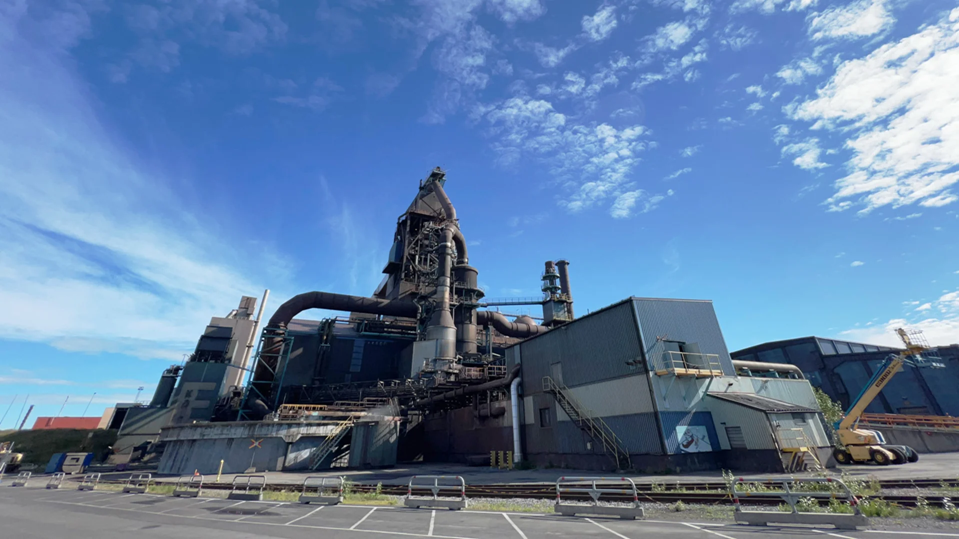Inside the Swedish factory that could be the future of green steel
July 30, 2024
Inside the Swedish factory that could be the future of green steel
In an excerpt from his new book, Rob Jackson explores what it will take to decarbonize one of the world’s dirtiest industries.
BY Rob Jackson
Diamonds are forever, except when they’re drill bits. The giant drill—20 feet long and mirroring a device in a Bond villain’s lair—griiinds amid a flood of sparks, flames, and molten iron gushing from the bottom of the newly punctured blast furnace into the torpedo-shaped rail cars a story below us. My safety glasses slip down the bridge of my nose in the heat.
Amidst the hissing hydraulics and safety beeps that announce the drill arm’s movement, Patrik Midebjörk motions me over. Midebjörk is blast furnace manager at SSAB’s steel plant in Luleå, Sweden, a stone’s throw below the Arctic Circle at the top of the Baltic Sea. He wears yellow-and-orange-striped overalls and rocks a white “SSAB” hard hat and graying goatee. As I edge nearer, Midebjörk trips a yellow lever to open a manhole-sized trapdoor in the floor and points to the glowing iron sloshing into the “torpedo” cars below. Each torpedo ferries iron across the plant for processing and slab casting. A scoreboard to our left displays a large red number that now reads “62” but ticks slowly upward. “Sixty-two percent full,” Midebjörk shouts to me, pointing to the railcar below. He drops the yellow lever and the trapdoor clangs shut.
You often hear that climate solutions are a matter of political and personal will. While that’s largely true in cases where low-carbon solutions are available, there are still industries that lack net-zero solutions. Long-haul airline travel is one. Heavy industry is another, especially businesses that require furnaces to make steel, cement, and aluminum. Steel companies produce almost 2 billion tons of steel a year worldwide but emit 3 billion to 4 billion tons of carbon dioxide pollution doing so—a towering 11% of global carbon emissions. If steel were a country, it would be the third biggest polluter on Earth.
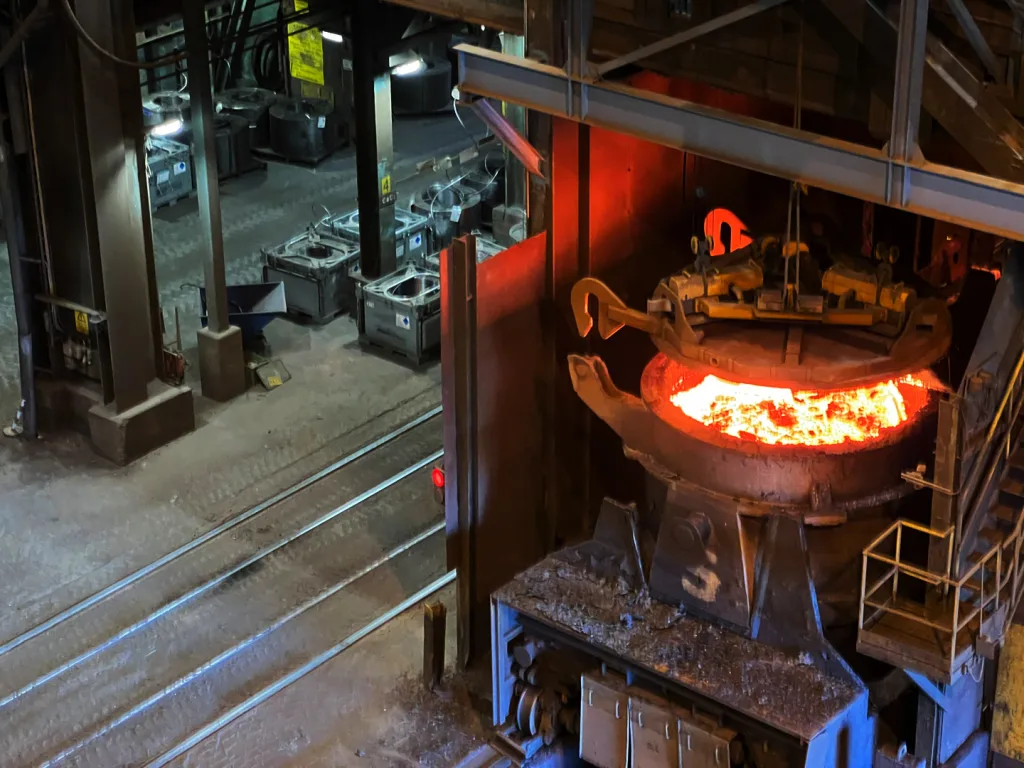
What makes steel production so carbon-intensive? First, primary steelmakers use the heat from coal to separate the iron from iron ore at high temperatures in a blast furnace (set your ovens to 3,000 degrees Fahrenheit, everyone?). The furnace uses coal both to melt the iron and to transform it chemically.
The blast furnace towering above me at Luleå is ringed at the bottom by dozens of super-sized vertical pipes resembling a monster car engine. The pipes “blast” high-pressure carbon monoxide (CO) made from coal through the race-car pipes into the bottom of the furnace to strip the extra oxygen found in iron ores. CO gas percolates up through the molten iron ore and extracts oxygen, forming—you guessed it—even more CO2.
Before the beads of sweat on our foreheads start to drip too much, we exit the blast-furnace warehouse down a long ramp. “Hands on the rail, please!” Midebjörk says. I stop and look back at the furnace building—part Burning Man, part steampunk in its multistory glory of rusted pipes, towers, and bell funnels.
Looking back with me, Midebjörk says wistfully, “She’s the grand dame. I hate it when people call her a dinosaur.” Pronouns aside, I see what he means. But dinosaur she will be if Midebjörk’s employer—SSAB—succeeds.
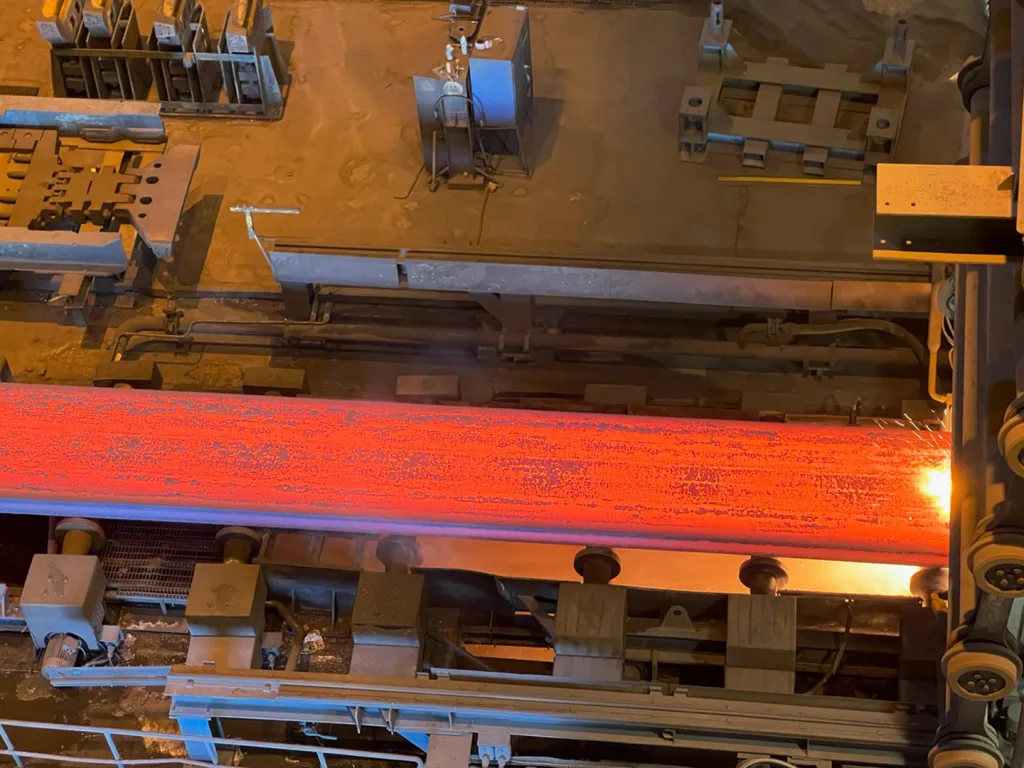
“It started as a . . . call it a crazy idea,” Martin Lindqvist, CEO of Svenskt Stål AB (SSAB), tells me, sitting 500 miles to the south in Stockholm. Before SSAB, no primary steel company—manufacturers that start with newly mined iron ore rather than recycled scrap metal—had made fossil-free steel before.
Lindqvist sits relaxed in casual corporate attire, but his passion for climate action is not casual. “We have to reach the goals of the Paris Accord,” he said, “and I’m personally very worried about it.”
He described SSAB’s pioneering path: “I think the idea came up back in 2014 or 2015. It took research, development, and a lot of money to develop our process. And to be honest, if you would have asked me a year ago if I was 100% sure we would succeed, I couldn’t have given you that promise.”
I asked if SSAB’s customers demand fossil-free steel. Lindqvist said, “Our customers believe that their customers will ask for green steel in the future, and they want to be part of solving this huge problem for society. For us, this step was easy. We reached out to the Volvo Group to be one of our first strategic partners. They buy a lot of steel and are long-term customers of ours.” Lindqvist asked them, “Do you want to be part of this journey?”
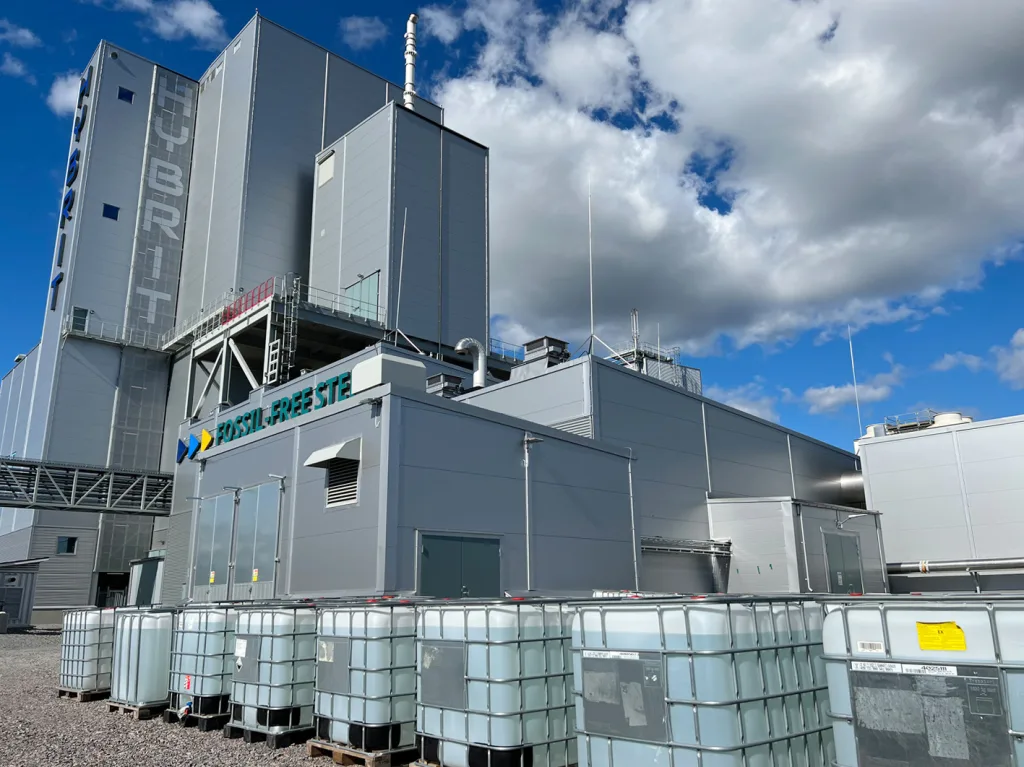
I recall his words later while crossing the Luleå plant to see his vision being realized. I arrive at a silver-cubist tower with prominent “HYBRIT” lettering down the building and “FOSSIL-FREE STEEL” in green block letters splashed across it. It’s muted in greenhouse gas emissions, if not in appearance.
To produce fossil-free steel, SSAB had to eliminate all the coal it used to generate heat to melt the iron ore and to scavenge the ore’s excess oxygen. The company settled on the idea of using green hydrogen (H2) made from renewable energy to heat their ovens and to remove the extra oxygen. Instead of emitting carbon dioxide, both steps would yield only water—if they had a fossil-free source of hydrogen.
To get it, they teamed up with long-term business partners Vattenfall and LKAB to form a consortium called HYBRIT (Hydrogen Breakthrough Ironmaking Technology). LKAB supplies SSAB with local iron ore, keeping transport costs down, while Vattenfall provides the power. “Vattenfall,” which means “waterfall” in Swedish, would supply the carbon-free electricity used to make green hydrogen through water-splitting electrolysis (H2O ? H2 and O2).
I greet Åsa Bäcklin of HYBRIT, my next host at the Luleå plant. “We make the green hydrogen here,” she tells me as we reach the electrolysis units. She points next to the silver tower above us, where the hydrogen contacts the iron ore to remove the oxygen. “The iron ore pellets go in on top and come out the bottom.” As the balls roll downwards in the cylinder, green hydrogen is blown into the bottom of the tower and passes upward through them.
Referring to the green hydrogen, Bäcklin says. “It captures the excess oxygen from the ore and leaves as water vapor. You put in a ball of iron ore up there. It’s still a ball when it comes out, but it’s slightly smaller because you’ve removed 30% of its weight as oxygen.” The pellets leaving the tower now have tiny holes in them—the reason they’re called “sponge iron.”
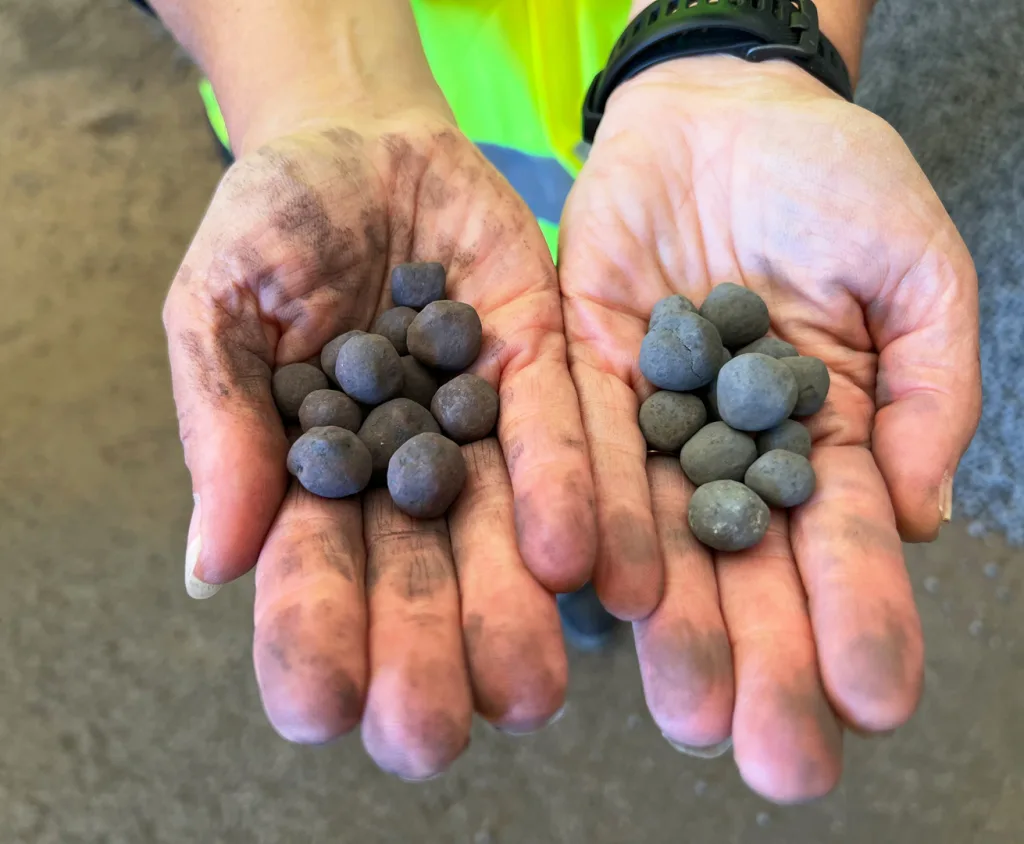
We reach an open warehouse with dumpster-sized piles of separate gray and red-brown balls the size of large marbles. The rust-colored ones I pick up come from the mined iron ore that LKAB supplies. The gray ones were converted to low-oxygen “sponge iron” using hydrogen in the tower above us.
I approach two head-high piles of pellets—one gray, one rusty brown. As I sift handfuls of the two piles, a one-tenth solution to climate change slips through my fingers like sand. Never before has climate action felt so tangible.
As a climate scientist, I seek hope. You visit a project like Luleå and think, “It’s so easy. Are we really going to fuck up the world’s climate till Doomsday when so many good solutions—and people—are out there?”
We are—if we don’t act faster and if companies worldwide keep polluting for free. And, as CEO Martin Lindqvist reminded me, nothing about SSAB’s journey was “easy.”
In August 2021, SSAB took the gray sponge iron produced by HYBRIT, melted it in a furnace fueled by renewable electricity, and produced the world’s first fossil-free steel. Volvo produced the world’s first vehicle made with it two months later. Volvo is already producing industrial equipment and heavy-duty electric trucks using HYBRIT steel and plans to release more green-steel vehicles soon. As a result, the HYBRIT partners are hiring workers and investing tens of billions of dollars to supply enough fossil-free steel to meet the growing demand.
I asked Lindqvist how much more green steel cost. He said, “Initially, we thought the cost would be 20% to 30% more.” That extra cost comes mainly from using green hydrogen instead of coal. But there’s another cost that SSAB incurs—something businesses in Europe face daily but most businesses in the United States do not—a fee to emit carbon dioxide pollution. In Europe, the polluter pays.
As a result, European business leaders have had to factor real carbon prices into their decisions for decades. By making its steel carbon-free, SSAB avoids paying hundreds of euros in carbon fees for every ton of steel it makes. Avoiding these fees pays for the carbon-free hydrogen that eliminates the need for coal. “So most of the price gap has disappeared,” Lindqvist said.
What’s economically feasible changes when markets price carbon pollution. “So, I would say,” Lindquist added, “in the future, depending on emission rates and the cost of emitting carbon, green steel won’t be more expensive at all. There’s a premium price for this product in the beginning, but over time, I expect that green steel will be preferred. Volvo, Daimler, and other companies are already eager to buy fossil-free steel. When the rest of the steel industry moves over to this technique, it will be the new normal.”
Completing my study of the bustling Luleå steel plant, Bäcklin passes me back to Patrik Midebjörk, who walks me to the steelworks downstream of the blast furnace. Torpedoes full of molten iron roll past us on rail lines. We step inside another warehouse to watch the torpedoes transfer their sloshing iron into giant cauldrons or ladles that slide across the shop floor. Here, additives such as chromium and nickel adjust how hard, strong, and flexible the steel will be.
Once the chemistry and temperature are Goldilocks perfect, the molten steel is poured from the ladles into the slab casters we see one floor below us. Cooling water rushes past, hissing and turning to steam as it contacts the red-hot steel. Twenty-ton slabs the length of school buses roll by to cool. Nearby, robotic magnets lift the cooled slabs and stack them like sawmill two-by-fours to be transported worldwide.
A fossil-free world needs stronger climate action and a price on greenhouse gas emissions. In ending our conversation, I asked Martin Lindqvist if he (and SSAB) supported such a price: “Of course we support a global price on carbon dioxide emissions. My opinion is that the process is too slow. I think it would be better if it cost even more to emit carbon dioxide in Europe and globally.”
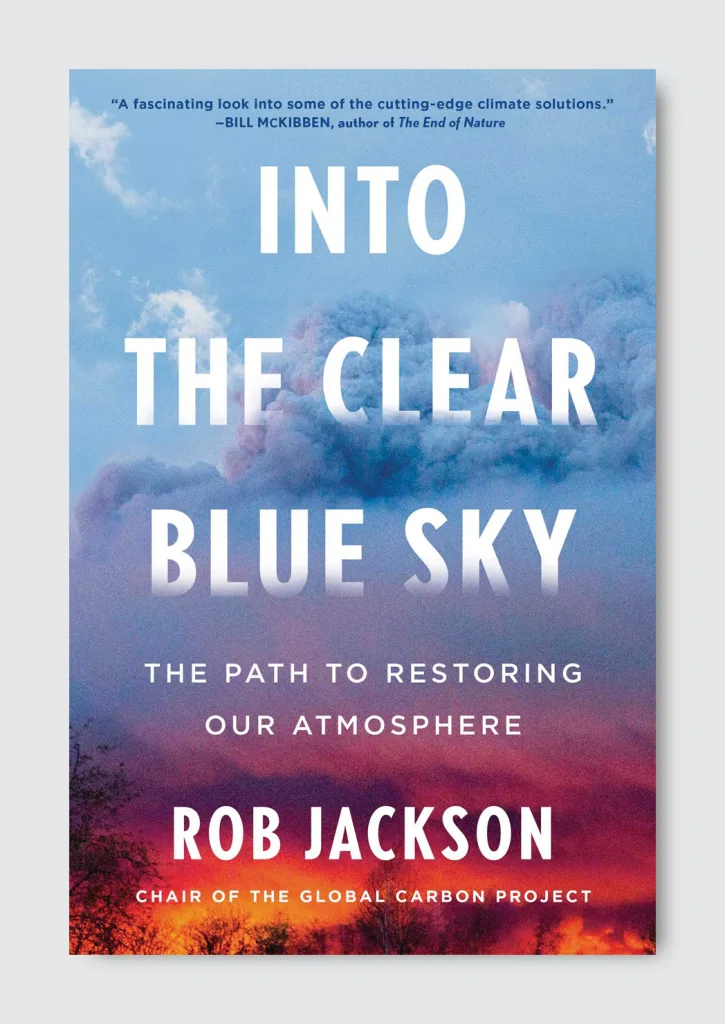
I’ve spoken with the CEOs of many companies who acknowledge that climate change is a serious problem. But I don’t recall another industrial CEO telling me the price of carbon pollution needs to be higher. No caveats, no qualifiers, and no hesitation. Just a call to action.
And Lindqvist definitely calls for action. “We’ve shown that there are solutions to reach the goals of the Paris Accord,” he said. “Something that was impossible a few years ago is now happening.”
He mentioned another motivation for his work. “I have three kids, including two daughters who are quite vocal about what they think needs to be done. You know Greta Thunberg is from Sweden; young people listen a lot to her. For the first time ever, my two daughters are proud of SSAB. They thought SSAB was just another shitty company, but now that we’re trying to do something that is really good for the environment, they are actually quite proud.”
Adapted from Into the Clear Blue Sky: The Path to Restoring Our Atmosphere by Rob Jackson.
ABOUT THE AUTHOR
Fast Company
(11)


